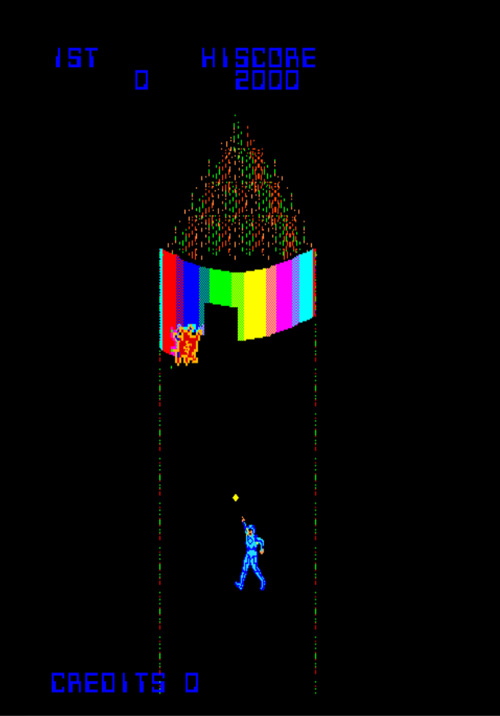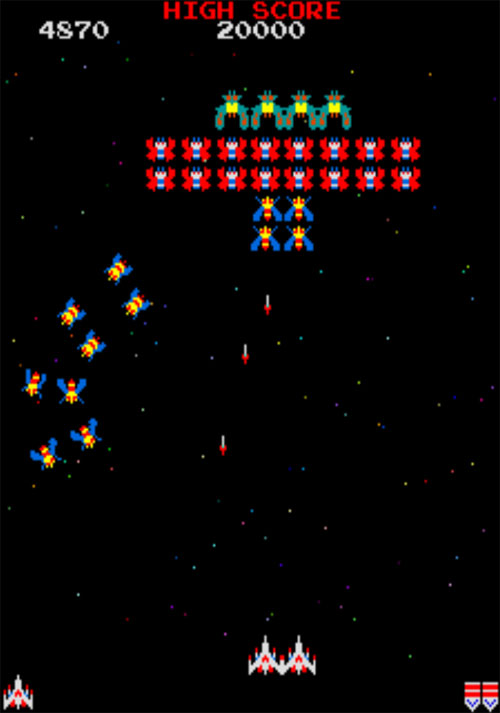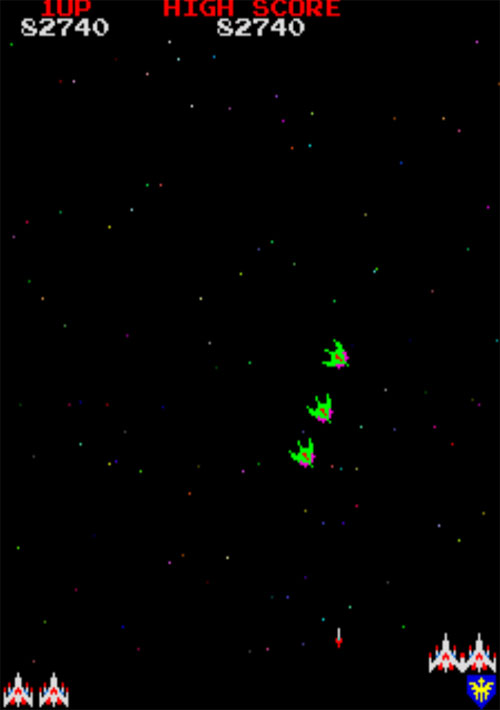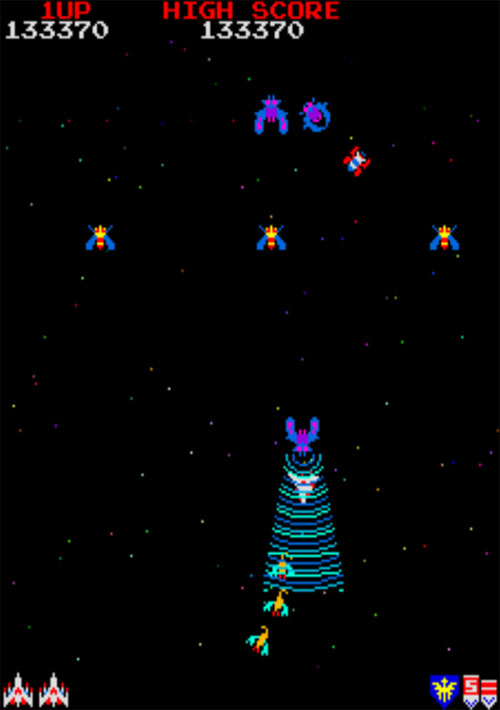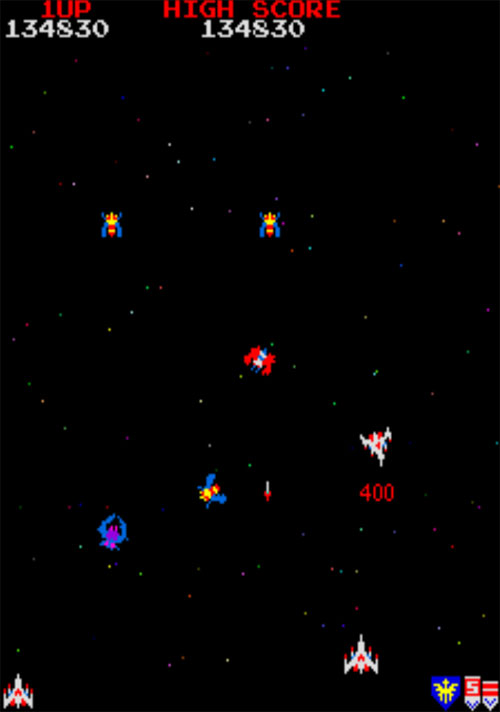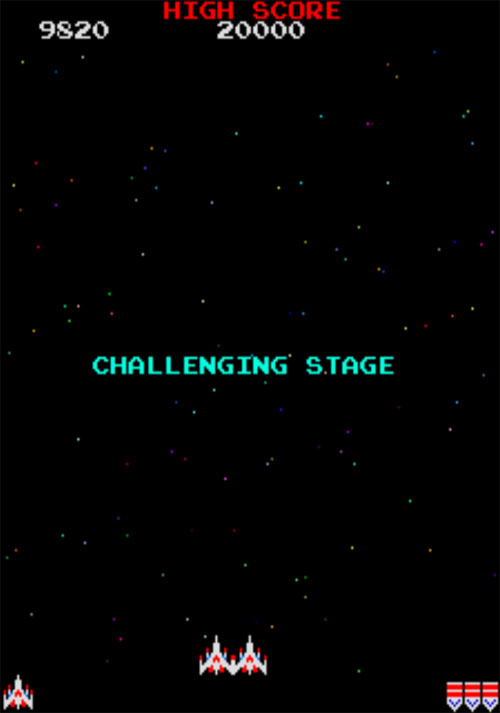
Clones are a tricky thing. If you simply take one well established idea, swap the color pallet and give it a slightly different name, everyone will call you out on it, if not outright sue your lazy ass. On the other hand, done right it can win over a lot of gaming fans with an insightful and creative slant on the well established norms.
Take Space Invaders, for a totally random example. Just about everyone with at least one functioning eyeball knows what it looks like and how it plays. Columns of blocky alien ships slowly crab-walk left and right, jumping down one row every time they reach the left or right edge of the screen. You control a ship on the bottom, and the object of the game is to clear the board of alien ships before they reach the bottom of the screen and nuke the world. Simple. Very simple. It's an easy concept to understand, and has an almost infinite range of possible enhancements. You know, like adding color and variety. Simple.
It's no surprise that there exactly 1,035,648,399 different clones of the original Space Invaders. Today, I'm taking a look at one of them, Taito's Akkanvader from 1995. It's colorful, cute, and best of all, fun!


Here's a look at the wide range of characters you have to pick from. Each character flies in a different ship, from the standard Invaders craft, to a dog in a trash can, to, well, a flying poo. Yep, those are poops on the right hand side. The character you choose has no bearing on the game, as each craft behaves in exactly the same way. Ultimately it just comes down to whether or not your want to be a flying space hero, dog, or pile of shit.

There are five main worlds, with several sub-stages in each main world. You'll fly through space stations, over a beach, over a giant ramen bowl, even through a haunted house. Each stage is practically vomiting colors out of the screen, from the colorful alien enemies, colorful backgrounds and colorful explosions and effects. Everything about Akkanvader is colorful as well as playfully animated, often making it quite difficult to tell just what the hell is going on. I'm not sure if this added level of difficulty is intentional or not, but it's ultimately a good thing, because Akkanvader is as easy as it is full of color.

Now that I've talked up the color angle, here's a look at the first stage. D'oh! Good ol' b&w retro goodness. If this doesn't immediately pull you in, then perhaps this isn't the game for you. In fact, Akkanvader really is a game just for those of us who have spent way too much time with the source material. To truly appreciate the game, a love of Space Invaders is a must.
Anyway, back to the stage. While the opening retro blast (right down to the awesome retro sounds!) is all well and good, these days we expect a little something more from our casual entertainment. So...

Hey look, color! You'll only get a few seconds to blast those cute little buggers before they quickly switch over to slightly more 3D and greatly more colorful little sprites with cute faces. So cute in fact that you'll be happy to shoot off those faces many, many times.
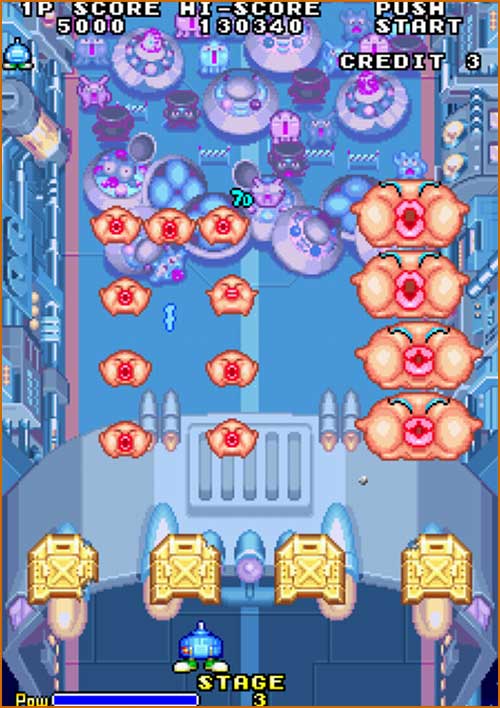
The aliens soon start to take on less traditional forms, like these large blobby guys that break up into smaller guys as you blast away at them.

One feature that Invaders didn't have was bosses. Akkanvader has a large boss at the end of each world. Here we see your basic robot boss, sending out his robot clone soldiers.
This is also a good time to mention that you have the ability to charge your laser by holding down the fire button. The only time this is of any use is when fighting the bosses. A few well aimed boosted shots and the boss will be doing the dance of death in no time.


There are plenty of off-beat baddies to blast to bits, like chickens, fish, octopi and ghosts. Some of them march left and right, some up and down, some in circles or in pyramid formation. There are also "bonus stages" where a few lines of aliens will shoot across the screen for your sharp-shooting pleasure. All of these variations touch on the original Invaders material, even if only in the most tenuous of ways.


Here we see another boss, this time a huge woman who seems to be wearing a red crab/bunny suit and large crab claws. Don't ask questions. It's all in a days work for our heroes.




This is the haunted house world. There are rows of coffins, plenty of mummified cat looking things and furniture that flings itself at you. That last image is of the boss, a sheet covered ghost who likes to keep his friends close at hand...when he's not tossing them at you, of course.


The final world pulls out all the stops, sending a withering array of aliens at you from throughout the entire game. My favorite bad guys are in this level, those little green guys. They are sent out en-mass to toss bombs at you. They have a cute bomb-tossing face, and an even cuter death animation. Nothing like getting a chuckle out of frying a few poor foot soldiers.

This is the final totally awesome boss. A giant Invader! He sends out equally giant spongy eye beams that you can deflect with a few shots, and a speedy zig-zag beam from his mouth. He also has a couple flailing arms and an array of beams that appear out of his body. He gradually walks toward the bottom of the screen before unleashing a barrage of attacks and moving back to the top. Again, a lot of dodging, boost shots and luck will get you past this guy in no time.



At the end you are rewarded with a bit of Enrgish and a couple happy heroes. And no chance to continue! Yeah, it's game over, no matter how well you played. Ah well, you'll want to jump back in right away regardless.
Akkanvader is a really fun, really mindless shooter. It's covered in frosting and candy sprinkles and will have you coming back for more, just like its great grandfather did way back when.
Here's a video of the first stage. I'll be adding more soon. Enjoy!






